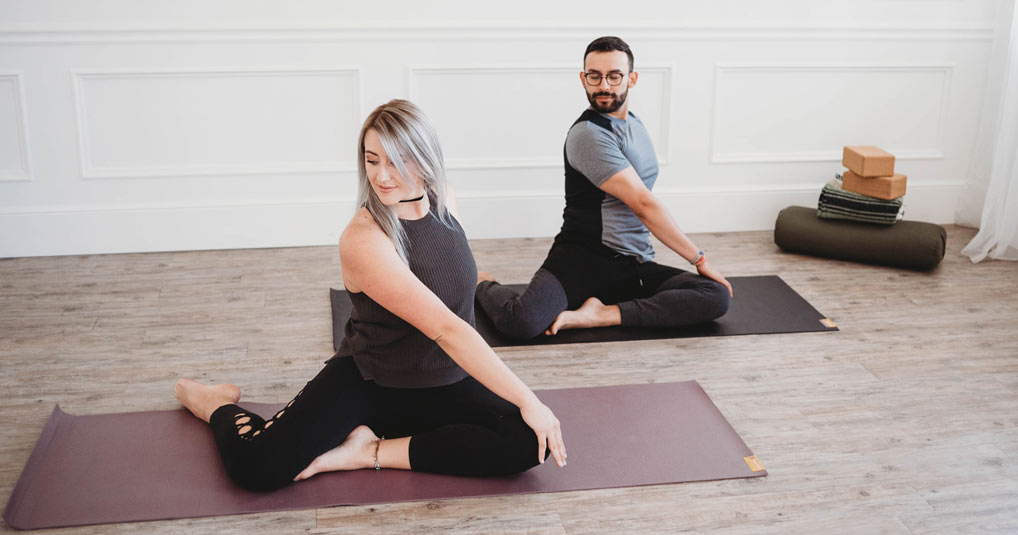
I regularly offer hip workshops at various teacher trainings in the region where I live. As the recipient of bilateral hip replacements, I’ve learned a lot about which poses and ways of approaching asanas promote healthy yoga practice, and which do not. Being bone on bone in your hip joints provides an unmistakable signal as to when to proceed or when to back off.
In one training, a student who had been teaching in a fitness studio asked a very important question. She explained that one of her female students became unusually flexible prior to ovulation. This occurs in many women because of the presence of “relaxin,” a hormone that relaxes the ligaments that hold together the various joints in the pelvis—hip joints, sacroiliac joints and pubic symphisis. The teacher said that she encouraged the student to move further into poses at that period in her cycle since she was already more flexible. “Should I continue doing this?” she asked.
Thirty years ago I would have said yes. In fact, I did encourage women to take advantage of their relaxin-induced flexibility during pregnancy. No more.
Ligaments Are Not Supposed to be Floppy
Fortunately, the third(!) time I took anatomy, the importance of understanding the structures of ligaments and tendons finally sank in. (For clarification, ligaments connect bone to bone in our joints; tendons connect muscle to bone at the joints.) Ligaments and tendons are constructed of dense, collagenous, connective tissue. Ligaments are dense, fibrous tissues that are designed to limit the movement of our joints.
Please repeat this three times: Ligaments’ main function is to limit the movement of our joints.
This is also very important: Ligaments and tendons are avascular, i.e. containing no blood flow of their own. Oxygen and other nutrients diffuse into ligaments and tendons from cells outside the tissues. Because these structures need to be strong, they are largely mostly collagen fibers with some elastin to create a small amount of stretch.
Don’t Sprain Your Body!
Have you ever sprained an ankle? How long did it take to heal, and did it ever return to its former stability? When you sprain your ankle, you overstretch ligaments. Because the tissue is avascular, it does not heal as quickly as muscle does. Ligaments do not have the “memory” that muscle tissue has. When you overstretch ligaments, there’s a good chance they will not bounce back to their former length.
If ligaments are meant to protect joints by limiting their movement, continually over-stretching joints can lead to joint instability over time. I know a number of serious practitioners who are now in their 50s—including myself—who regret having overstretched our joints back in the day. All too many longtime practitioners now own artificial joints to replace the ones they overused. Those fancy poses way back when were not worth their consequences.
Flexible people have a much stronger tendency to overstretch joints than stiffer people do. Armed with the pervasive “no pain, no gain” philosophy, we flexies tend to keep stretching until we feel pain. Because we don’t feel much in normal range of motion, we collapse into our joints where there’s plenty of sensation. Not only does this overstretch our ligaments, it causes us to hang or push into our joint capsules, which can wear down the cartilage that protects our joints and keeps them articulating smoothly.
The Counterintuitive Answer for Healthy Yoga Practice
My advice to the student’s question was to encourage her student to protect her joints, to do less rather than more. Counterintuitive, I know, especially when many asana classes encourage people to push past their limits and rock those fancy poses. If a person’s ligaments are unstable because of an infusion of relaxin—or by excessive heat or any other outside factor—that creates a situation of imbalance in the joints.
You wouldn’t encourage a muscle-bound yoga student to lift more weights and stiffen up. Equally, a too-flexible student doesn’t benefit from becoming even more flexible. Too much flexibility is just as unhealthy is too much stiffness. Balance is what we’re going for in asana practice. Familiarize yourself with what normal range of motion looks like.
Stretch Gently for Healthy Yoga Practice
By all means, do practice to maintain flexibility in your muscles, and remember that it takes 30 seconds of continuous stretching for your muscle spindle neuron to actually allow your muscle to habituate to a new, longer length. So take your time, and be gentle. When you feel tissue stretching along the bones—as long as that stretch is not extreme—it’s probably healthy. When you feel discomfort in a joint, please stop doing what you’re doing. And please protect your students’ future joints by teaching them the difference.
If you’re interested in exploring this further, my book Hip-Healthy Asana provides anatomical information, practice tips and a list of hip-healthy poses.
